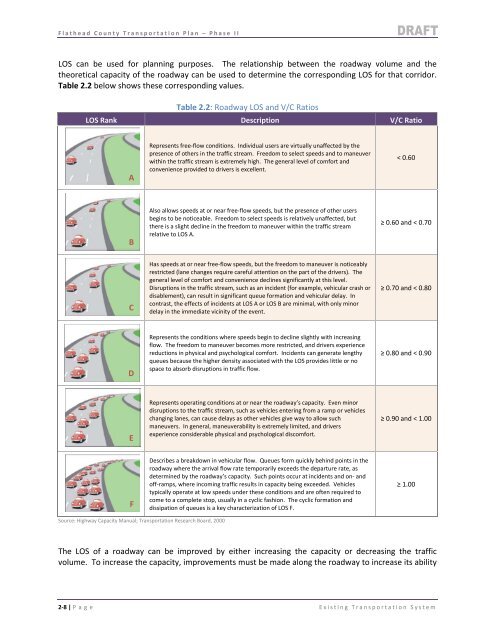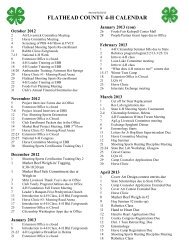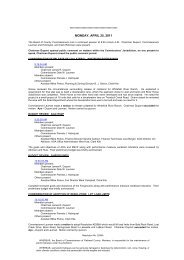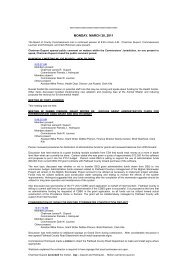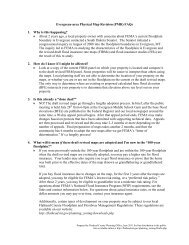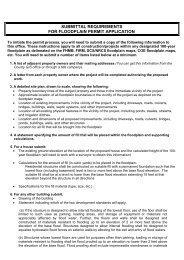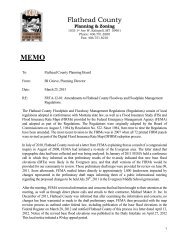Flathead County Transportation Plan – Phase II
Flathead County Transportation Plan – Phase II
Flathead County Transportation Plan – Phase II
You also want an ePaper? Increase the reach of your titles
YUMPU automatically turns print PDFs into web optimized ePapers that Google loves.
<strong>Flathead</strong> <strong>County</strong> <strong>Transportation</strong> <strong>Plan</strong> <strong>–</strong> <strong>Phase</strong> <strong>II</strong><br />
LOS can be used for planning purposes. The relationship between the roadway volume and the<br />
theoretical capacity of the roadway can be used to determine the corresponding LOS for that corridor.<br />
Table 2.2 below shows these corresponding values.<br />
Table 2.2: Roadway LOS and V/C Ratios<br />
LOS Rank Description V/C Ratio<br />
A<br />
B<br />
C<br />
D<br />
E<br />
F<br />
Source: Highway Capacity Manual; <strong>Transportation</strong> Research Board, 2000<br />
Represents free‐flow conditions. Individual users are virtually unaffected by the<br />
presence of others in the traffic stream. Freedom to select speeds and to maneuver<br />
within the traffic stream is extremely high. The general level of comfort and<br />
convenience provided to drivers is excellent.<br />
Also allows speeds at or near free‐flow speeds, but the presence of other users<br />
begins to be noticeable. Freedom to select speeds is relatively unaffected, but<br />
there is a slight decline in the freedom to maneuver within the traffic stream<br />
relative to LOS A.<br />
Has speeds at or near free‐flow speeds, but the freedom to maneuver is noticeably<br />
restricted (lane changes require careful attention on the part of the drivers). The<br />
general level of comfort and convenience declines significantly at this level.<br />
Disruptions in the traffic stream, such as an incident (for example, vehicular crash or<br />
disablement), can result in significant queue formation and vehicular delay. In<br />
contrast, the effects of incidents at LOS A or LOS B are minimal, with only minor<br />
delay in the immediate vicinity of the event.<br />
Represents the conditions where speeds begin to decline slightly with increasing<br />
flow. The freedom to maneuver becomes more restricted, and drivers experience<br />
reductions in physical and psychological comfort. Incidents can generate lengthy<br />
queues because the higher density associated with the LOS provides little or no<br />
space to absorb disruptions in traffic flow.<br />
Represents operating conditions at or near the roadway’s capacity. Even minor<br />
disruptions to the traffic stream, such as vehicles entering from a ramp or vehicles<br />
changing lanes, can cause delays as other vehicles give way to allow such<br />
maneuvers. In general, maneuverability is extremely limited, and drivers<br />
experience considerable physical and psychological discomfort.<br />
Describes a breakdown in vehicular flow. Queues form quickly behind points in the<br />
roadway where the arrival flow rate temporarily exceeds the departure rate, as<br />
determined by the roadway’s capacity. Such points occur at incidents and on‐ and<br />
off‐ramps, where incoming traffic results in capacity being exceeded. Vehicles<br />
typically operate at low speeds under these conditions and are often required to<br />
come to a complete stop, usually in a cyclic fashion. The cyclic formation and<br />
dissipation of queues is a key characterization of LOS F.<br />
2‐8 | P age Existing <strong>Transportation</strong> System<br />
< 0.60<br />
≥ 0.60 and < 0.70<br />
≥ 0.70 and < 0.80<br />
≥ 0.80 and < 0.90<br />
≥ 0.90 and < 1.00<br />
The LOS of a roadway can be improved by either increasing the capacity or decreasing the traffic<br />
volume. To increase the capacity, improvements must be made along the roadway to increase its ability<br />
≥ 1.00


